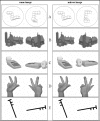Different strategies do not moderate primary motor cortex involvement in mental rotation: a TMS study
- PMID: 17683644
- PMCID: PMC1994952
- DOI: 10.1186/1744-9081-3-38
Different strategies do not moderate primary motor cortex involvement in mental rotation: a TMS study
Abstract
Background: Regions of the dorsal visual stream are known to play an essential role during the process of mental rotation. The functional role of the primary motor cortex (M1) in mental rotation is however less clear. It has been suggested that the strategy used to mentally rotate objects determines M1 involvement. Based on the strategy hypothesis that distinguishes between an internal and an external strategy, our study was designed to specifically test the relation between strategy and M1 activity.
Methods: Twenty-two subjects were asked to participate in a standard mental rotation task. We used specific picture stimuli that were supposed to trigger either the internal (e.g. pictures of hands or tools) or the external strategy (e.g. pictures of houses or abstract figures). The strategy hypothesis predicts an involvement of M1 only in case of stimuli triggering the internal strategy (imagine grasping and rotating the object by oneself). Single-pulse Transcranial Magnetic Stimulation (TMS) was employed to quantify M1 activity during task performance by measuring Motor Evoked Potentials (MEPs) at the right hand muscle.
Results: Contrary to the strategy hypothesis, we found no interaction between stimulus category and corticospinal excitability. Instead, corticospinal excitability was generally increased compared with a resting baseline although subjects indicated more frequent use of the external strategy for all object categories.
Conclusion: This finding suggests that M1 involvement is not exclusively linked with the use of the internal strategy but rather directly with the process of mental rotation. Alternatively, our results might support the hypothesis that M1 is active due to a 'spill-over' effect from adjacent brain regions.
Figures



References
LinkOut - more resources
Full Text Sources

